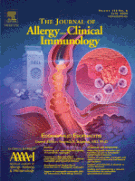Structural basis for epitopes sharing between group 1 allergens of cedar pollen, Jun a 1 and Cry j 1 - 25/08/11
Abstract |
Rationale |
Resolution of the 3D-structures and IgE epitopes of allergens may identify common or conserved features important for the biological activity of allergens.
Methods |
Purified Jun a 1 was crystallized using the hanging-drop vapour-diffusion method at 277 K. The crystals are monoclinic, P21, with unit-cell parameters a=53.38 Å, b=113.48 Å, c=72.44 Å, β=96.36°, Z=4. A 1.7 ± data set has been collected at 100 K with X-rays from the synchrotron at the Advanced Photon Source. The crystal structure has been solved using Multiple Isomorphous Replacement. Analysis of the crystal structure places the four IgE binding sites on the surface of the Jun a 1. Synthetic, overlapping peptides of Jun a 1 and sera from patients allergic to mountain cedar and Japanese cedar pollen were used to determine the epitopes. 3D model of Cry j 1 was produced using the crystal structure of Jun a 1 as a template.
Results |
We identified four IgE binding sites on Jun a 1 and three on Cry j 1. Two shared IgE epitopes mapped to turns or loops on the surface, while the third mapped to a β-sheet region homologous to pectate lyase catalytic sites.
Conclusions |
A major linear IgE epitope is present within the highly conserved catalytic regions of group 1 cedar allergens providing a structural basis for the high degree of cross-reactivity between cedar pollen allergens. Similar patterns of reactivity may be common to other allergens.
El texto completo de este artículo está disponible en PDF.| Funding: Parker B. Francis Foundation |
Vol 113 - N° 2S
P. S335 - février 2004 Regresar al númeroBienvenido a EM-consulte, la referencia de los profesionales de la salud.
El acceso al texto completo de este artículo requiere una suscripción.
¿Ya suscrito a @@106933@@ revista ?

